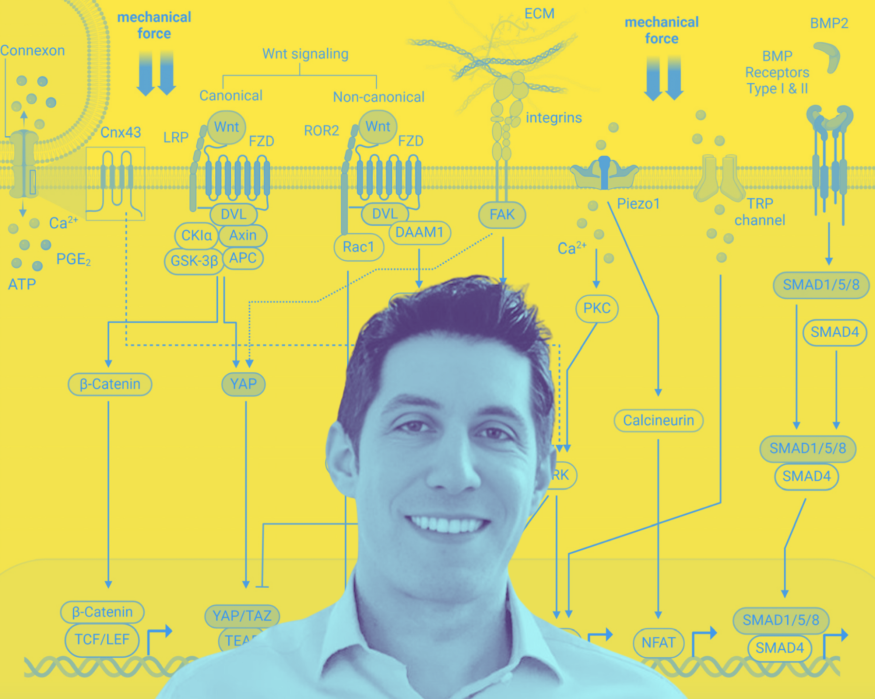
Imagine the gentle ripple of a heartbeat traveling through tissue or the forceful bend of a limb during exercise: every subtle push and pull exerts an unseen influence on our cells, inducing them into setting off a series of biochemical signals. At the center of this phenomenon are mechanosensors, specialized proteins like integrins that link the cell's external structure to its internal scaffolding. When mechanical tension bends or twists these proteins, it sets off a domino effect: ion channels open, allowing bursts of calcium and other molecules into the cell; enzymes such as kinases switch on like tiny biochemical power plants; and ultimately, genes can be activated or silenced, reshaping cellular functions in everything from muscle repair to tissue growth.
This intricate communication between mechanical force and cellular chemistry reveals that our bodies don't just endure mechanical stress—they interpret it with remarkable sensitivity, translating physical signals into biological action. Using Artificial Intelligence and chemical engineering, trailblazing life sciences company Xenco Medical is targeting this cellular mechanosensitivity to accelerate bone regeneration. Recently named one of the World's Most Innovative Companies by Fast Company Magazine for the second time, Xenco Medical has established itself as a pioneer in medical technology. We spoke with Jason Haider, the company's Founder and CEO, on how Xenco Medical is unlocking the body's regenerative potential through its groundbreaking technology.
Asked to encapsulate the science that underpins the company's TrabeculeX Continuum technology, Haider offered, "the guiding principle that defines the ways in which each synergistic component that comprises the TrabeculeX Continuum works towards regeneration is mechanotransduction. When we began to engineer a longitudinal intervention that harmonized biomaterial induced bone regeneration and activity-induced bone formation, it became clear early on that the incorporation of AI would be essential to guide patient-specific, mechanotransductive rehabilitation protocols that intentionally amplified the regenerative potential of our biomaterial."
Responding to a question about the sequence of steps that unfold in the regeneration process using the company's technology, Haider noted, "well, the cascaded process we designed into the TrabeculeX Continuum begins at the sub-micron scale, where our TrabeculeX Bioactive Matrix's surface topography was optimized to begin the bone remodeling process through a calibrated orchestration of osteoblast and osteoclast activity." Haider continued, "The amplification of this regenerative process occurs in the remote therapeutic monitoring and rehab stage, where the principles of mechanotransduction are applied to induce signaling cascades like the Wnt/β-catenin pathway. There is a profound network of intercommunication in our osteocyte lacuno-canalicular systems that we wanted to harness as part of a sustained intervention."
When asked about the gap the company's technology was filling, Haider answered with, "bone remodeling is a longitudinal process that was not reflected in the existing technologies available to patients. Rather than limiting a regenerative intervention to a silo of care, it was important for us to create an AI-enabled bridge that ensured both the intraoperative and post-operative phases of a patient's recovery were robustly engaged." Haider added, "It became a mission of ours to create a platform that transcended implantation alone and enhanced local osteogenic factors through cyclical mechanical stimulation as well." The gap Xenco Medical is filling may extend to healthcare providers as well. According to findings in an April 2024 study published in the Journal of the American Medical Informatics Association, the incorporation of digital health technologies into patient interventions reduced the cognitive and emotional load on healthcare providers due to labor shortages across the country. With the criticality of these shortages receiving growing attention, other life sciences companies in fields outside of orthopedics may also engineer longitudinal interventions akin to what Xenco Medical has brought to market. As manufacturers respond to this rapidly changing landscape, we will continue to report on breakthroughs transforming healthcare.










